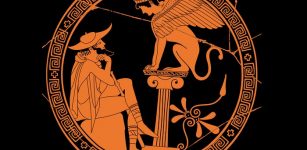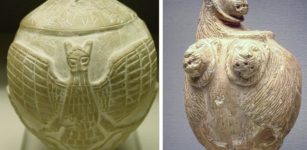Why Did A Solar Eclipse Save George Davidson’s Life In Alaska?
Conny Waters - AncientPages.com - Scientific curiosity and searching for knowledge can sometimes be dangerous. This is a lesson American astronomer and geographer George Davidson learned when he traveled with his research team to Klukwan, near Haines in southeast Alaska, in 1869.
Ancient people have always been fascinated with solar eclipses, but the understanding of this natural phenomenon has varied among civilizations.
Famous Greek philosopher and scientist Thales of Miletus (625 BC - 545 BC), who was recognized as one of the seven sages of ancient Greece, was a brilliant astronomer who predicted an eclipse of the sun that occurred on 28 May 585 B.C.
George Davidson (1825 - 1911). Credit: Public Domain
Ancient civilizations found astronomical phenomena fascinating, and many studied the Sun, Moon, and other celestial objects regularly. Solar eclipses are often used as fixed point-to-date events in the ancient world. Using a combination of a Biblical text and an ancient Egyptian text, scientists have been able to pinpoint the date when world’s oldest solar eclipse took place.
The event, which occurred on 30 October 1207 BC, is mentioned in the Bible and could have consequences for the chronology of the ancient world.
Ancient people studied solar eclipses regularly. Our ancestors were so impressed that some ancient solar eclipses re-wrote history. There were also moments when the darkness of the skies was seen as an omen or sign from God. Some ancient solar eclipses have stayed in people's memory for generations.
Some civilizations found solar eclipses very frightening, and this fact saved George Davidson's life.
Davidson visited Alaska primarily to observe a total solar eclipse occurring on August 7, 1869. He made his headquarters at an Indian village thirty miles from the mouth of the Chilkat River.
Davidson and his team selected this particular place because they knew it would be particularly clear to observe the upcoming solar eclipse.
However, a Native American tribe in the valley spotted the scientists, and the suspicious locals became angry and threatening.
When Davidson explained that a solar eclipse would occur the following day, the Indians temporarily left them alone.
When the eclipse really happened, the Indians fled, and the sudden darkness saved the scientists' lives. Later, the Indians returned, and they were very impressed with Davidson’s knowledge of the event they had witnessed. The solar eclipse led to a remarkable intellectual potlatch, an ancient North American Indian tradition of ceremonial exchange of gifts.
“In the days afterwards, Davidson made a painting on a cedar plank of the sun and its corona, as he had seen it at totality in his specially prepared telescope.”
In exchange, Kohklux and his wives made a large map for Davidson, presenting the complex geography of the main ancient trade routes used by the Chilkat Tlingit. 1
“At his own suggestion Kohklux proposed to draw upon paper his route,” Davidson later noted. “Kohklux started from his place at Klukwan and drew all around the paper and I gave him the back of an old map on which he and his wife drew their routes etc. in 1852.”
A lithograph of the sun and solar corona, as observed by George Davidson at Klukwan, August 8, 1869, appeared in the Coast Survey annual report for 1869.
The chief detailed the long-established trading route up the Chilkat River, over the pass, and through the Southern Tutchone trading centers of Neskatahin, Hutshi, and Aishihik en route to the Yukon River. The Chilkat Tlingit had long maintained strict control over the trade in furs between the interior and the coast. Acting as powerful middle marketers, the Tlingit mediated trade relations between Russian and later Hudson's Bay Company and American maritime merchants. The route that Glave and his party“pioneered” had a long and well-trodden history.
“Lying face downward the old chief and his wife discussed and laboriously drew on the back of an old chart the lines of all the water courses, and lakes with the profile of the mountains as they appear on either hand from the trail… and the limit of each of the fourteen days journey across to Fort Selkirk is marked by cross-lines on this original Chilkat map,” as a National Geographic magazine writer, Eliza Scidmore, explained this episode of indigenous mapmaking. So accurate was the map, according to Scid- more, that “this Kloh-Kutz map was the basis of the first charts.
”But the map was not only a relatively accurate representation of the topographical features of this critical trade route; the map was also a memory.” 2
Written by Conny Waters – AncientPages.com Staff Writer
First version of this article was published on April 3, 2020
Copyright © AncientPages.com All rights reserved. This material may not be published, broadcast, rewritten or redistributed in whole or part without the express written permission of AncientPages.com
Expand for referencesReferences:
- John Cloud - The Tlingit Map of 1869, Penn Museum
- Robert Campbell - In Darkest Alaska: Travel and Empire Along the Inside Passage
- Wagner, Henry R. "George Davidson, Geographer of the Northwest Coast of America." California Historical Society Quarterly 11, no. 4 (1932): 299-320. Accessed April 2, 2020. doi:10.2307/25178166.
- Campbell, W. W. "THE ASTRONOMICAL ACTIVITIES OF PROFESSOR GEORGE DAVIDSON." Publications of the Astronomical Society of the Pacific 26, no. 152 (1914): 28-37.
More From Ancient Pages
-
 Long-Lost Anglo-Saxon Monastery Ruled By Queen Cynethryth Of Mercia Discovered By Archaeologists
Archaeology | Aug 19, 2021
Long-Lost Anglo-Saxon Monastery Ruled By Queen Cynethryth Of Mercia Discovered By Archaeologists
Archaeology | Aug 19, 2021 -
 Yungang Grottoes: Marvellous Example Of Ancient Buddhist Rock-Cut Architecture
Featured Stories | Sep 15, 2015
Yungang Grottoes: Marvellous Example Of Ancient Buddhist Rock-Cut Architecture
Featured Stories | Sep 15, 2015 -
 Evidence Of An Unknown Ancient Civilization In The Yucatan?
Featured Stories | Apr 6, 2024
Evidence Of An Unknown Ancient Civilization In The Yucatan?
Featured Stories | Apr 6, 2024 -
 Is Ipuwer Papyrus A Report Of An Ancient Catastrophe?
Artifacts | Aug 7, 2017
Is Ipuwer Papyrus A Report Of An Ancient Catastrophe?
Artifacts | Aug 7, 2017 -
 Ancient Secrets Of Dougong Brackets: How 2,500-Year-Old Buildings Could Survive Earthquakes
Ancient History Facts | Jul 31, 2017
Ancient Secrets Of Dougong Brackets: How 2,500-Year-Old Buildings Could Survive Earthquakes
Ancient History Facts | Jul 31, 2017 -
 Salzburg Catacombs: Early Christian Place For Secret Gatherings And Hiding From Persecution
Featured Stories | Mar 16, 2016
Salzburg Catacombs: Early Christian Place For Secret Gatherings And Hiding From Persecution
Featured Stories | Mar 16, 2016 -
 Ancient DNA Unravels The Mystery Of Huge 6,500-Year-Old Cemetery And The Tomb Of A ‘Masculine Woman’ In Normandy, France
Archaeology | May 5, 2022
Ancient DNA Unravels The Mystery Of Huge 6,500-Year-Old Cemetery And The Tomb Of A ‘Masculine Woman’ In Normandy, France
Archaeology | May 5, 2022 -
 How Did A Rare 2,000-Year-Old Gem Seal Depicting God Apollo End Up In The City Of David?
Archaeology | Nov 5, 2020
How Did A Rare 2,000-Year-Old Gem Seal Depicting God Apollo End Up In The City Of David?
Archaeology | Nov 5, 2020 -
 Oedipus – Tragic Prophecy About A Man Who Couldn’t Escape Fate
Featured Stories | Jan 10, 2019
Oedipus – Tragic Prophecy About A Man Who Couldn’t Escape Fate
Featured Stories | Jan 10, 2019 -
 Triumphal Arch Of Roman Emperor Constantine And His Great Vision
Featured Stories | Jul 12, 2017
Triumphal Arch Of Roman Emperor Constantine And His Great Vision
Featured Stories | Jul 12, 2017 -
 Avraga In Eastern Mongolia Was Winter Base Camp Of Genghis Khan – Study
Archaeology | Jul 8, 2020
Avraga In Eastern Mongolia Was Winter Base Camp Of Genghis Khan – Study
Archaeology | Jul 8, 2020 -
 Has The Legendary Viking Stronghold Jomsborg Finally Been Found?
Archaeology | Jun 3, 2023
Has The Legendary Viking Stronghold Jomsborg Finally Been Found?
Archaeology | Jun 3, 2023 -
 ‘Stone Club Head Of Mesilim’ Probably The Most Powerful Sumerian Ruler At That Time
Artifacts | Oct 12, 2017
‘Stone Club Head Of Mesilim’ Probably The Most Powerful Sumerian Ruler At That Time
Artifacts | Oct 12, 2017 -
 Biblical Mystery Of Urim And Thummim: God’s Puzzling Communication Devices
Ancient Mysteries | Jun 18, 2017
Biblical Mystery Of Urim And Thummim: God’s Puzzling Communication Devices
Ancient Mysteries | Jun 18, 2017 -
 Huge Unknown Ancient Lost World Discovered Inside Giant Sinkhole In China
News | May 19, 2022
Huge Unknown Ancient Lost World Discovered Inside Giant Sinkhole In China
News | May 19, 2022 -
 13,000-Year-Old Human Footprints Discovered In Canada
Archaeology | Mar 30, 2018
13,000-Year-Old Human Footprints Discovered In Canada
Archaeology | Mar 30, 2018 -
 Mysterious Ancient Inscription With Unknown Language Found Near Lake Bashplemi, Georgia
Linguistic Discoveries | Dec 4, 2024
Mysterious Ancient Inscription With Unknown Language Found Near Lake Bashplemi, Georgia
Linguistic Discoveries | Dec 4, 2024 -
 Stolen Artifacts Returned To Pompeii – Believed To Be Cursed -They Brought Misfortunes To A Woman And Her Family
Artifacts | Oct 13, 2020
Stolen Artifacts Returned To Pompeii – Believed To Be Cursed -They Brought Misfortunes To A Woman And Her Family
Artifacts | Oct 13, 2020 -
 Aaru – Field Of Reeds: Kingdom Of Osiris Was The Ancient Egyptian Paradise
Myths & Legends | Feb 29, 2024
Aaru – Field Of Reeds: Kingdom Of Osiris Was The Ancient Egyptian Paradise
Myths & Legends | Feb 29, 2024 -
 Babylon’s Kiln-Fired Bricks Almost Erased The City From History
Featured Stories | Dec 13, 2018
Babylon’s Kiln-Fired Bricks Almost Erased The City From History
Featured Stories | Dec 13, 2018


